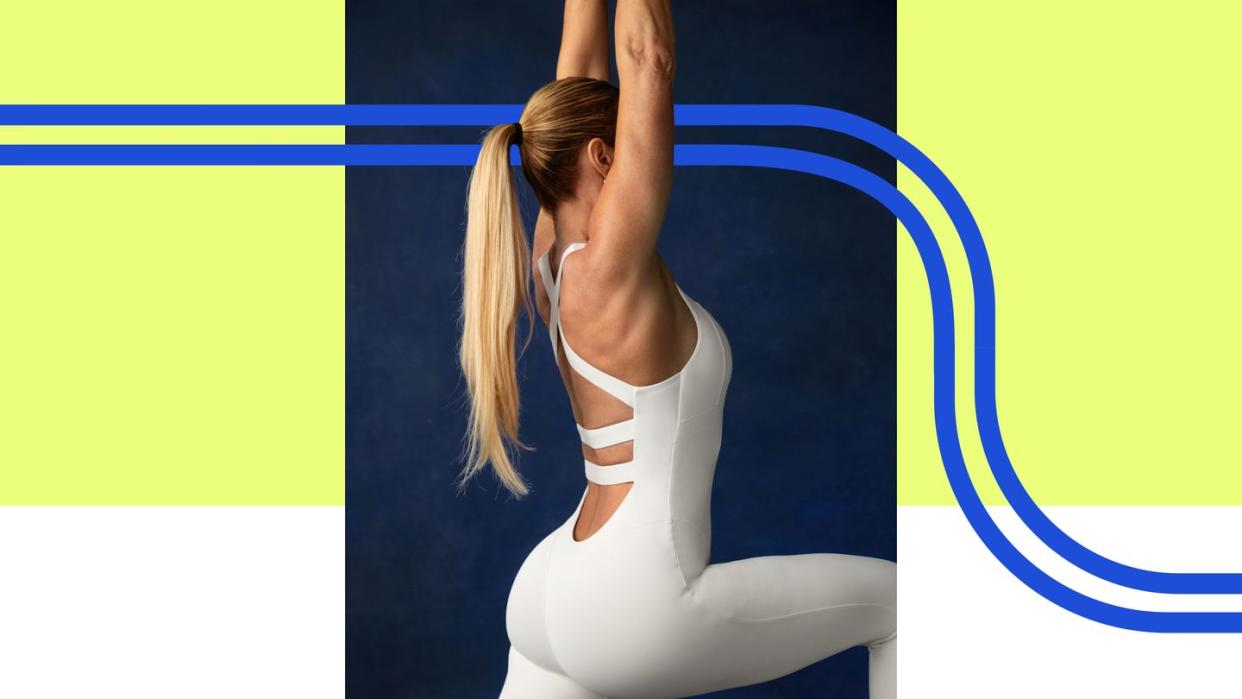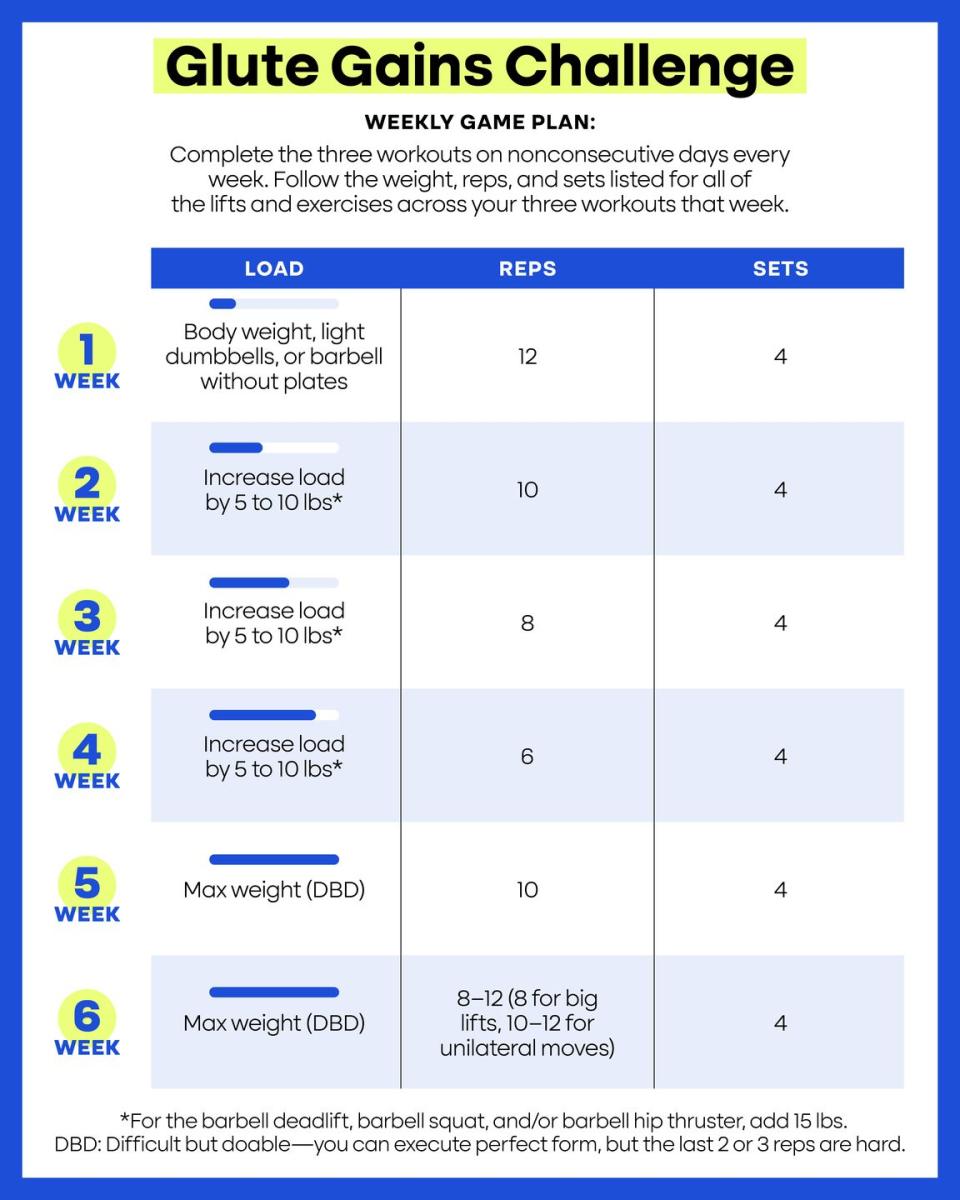This Butt Workout Targets The Tough-To-Reach Gluteus Medius Muscle

In Workout 2 of the WH Glute Gains Challenge, the glute medius is the star performer—and for good reason. The gluteus medius is key to sculpting amazing glutes, aesthetically *and* functionally speaking.
The glute “med” can be harder to target given its position compared with the larger glute maximus. But a great way to tap the gluteus medius as the main working muscle is with lateral movements, such as lateral lunges, says Sandy Brockman, CPT. “Incorporating lateral movement into a glute program is very important to create well-rounded, athletic, strong glutes,” she explains. (Yes, please!)
The role of the gluteus medius, which sits on the lateral part of the upper buttock, is essential when it comes to stabilization and mobility of the pelvis and thigh. The glute “med” is also a key player whenever you walk, run, and do single-leg strength exercises, as it works to prevent the opposite side of your pelvis from dropping or slipping out of alignment during those actions.
Ready to sculpt? Let’s go.
Meet the expert: Sandy Brockman is a certified personal trainer at Kollective in Austin, Texas. She helps women build muscle and transform their bodies and health through strength training with a focus on glutes.

Workout 2
INSTRUCTIONS: Complete three rounds of the warm-up exercises in order with as little rest as possible between moves and sets. (This should take you approximately five minutes.) Then move through the exercises in Lift A, with little to no rest between moves, repeating the Lift A circuit for four rounds, including the corrective. Then move on to Lift B and complete in the same fashion. Consult the chart below for each week’s rep scheme and suggested weight.
Workout 2 Cheat Sheet:
Warm-Up (3 rounds):
Air Squat, 10 reps
Jump Squat, 5 reps
Reverse Lunge, 5 reps alternating
Butterfly Situp, 5 reps
Plank, 30 second hold
Couch Stretch with Activation, 30 seconds each side
Lift A (4 rounds, 6 - 12 reps each based on chart below):
Barbell Deadlift
Lateral Lunge to Box
Deep Squat to Internal Rotation, 1 minute each side
Lift B (4 rounds, 6 - 12 reps each based on chart below):
Single-Leg Bench RDL
Frog Stretch with Activation, 1 minute each side
TIME: 45–60 minutes
EQUIPMENT: Mat, box or bench, dumbbells and/or barbell with weight plates, bumper plates, clips
How To Choose The Right Weight
The key to success is following Brockman’s DBD protocol: The weight you select should feel Difficult But Doable. If you’re a beginner and have no idea where to start, Brockman suggests going with a 35-pound barbell (which is the skinnier barbell with no weight plates) and/or 5- to 10-pound dumbbells. Then try to go up in weight week over week. A rule of thumb to keep in mind? If you feel you can go heavier without sacrificing form, you should.

WARM-UP: Air Squat

How to:
Stand with feet shoulder-width apart with pelvis tucked, glutes squeezed, and arms at sides.
Initiate a squat by engaging glutes and hinging at hips as you clasp hands in front of chest, descending until hips are parallel (or slightly lower than parallel) to floor.
Immediately reverse movement to return to start. That’s 1 rep. Do 10 reps.
WARM-UP: Jump Squat

How to:
Stand with feet shoulder-width apart with pelvis tucked, glutes squeezed, and arms at sides.
Initiate a squat by engaging glutes and hinging at hips as you clasp hands in front of chest.
Immediately jump up into the air, bringing arms behind you. That’s 1 rep. Do 5 reps.
WARM-UP: Reverse Lunge

How to:
Stand with feet hip-width apart with pelvis tucked, glutes squeezed, and hands clasped in front of chest.
Step left leg back into a lunge, then immediately step back to starting position.
Step right leg back into a lunge, then return to start. That’s 1 rep. Continue alternating for 5 total reps.
WARM-UP: Butterfly Sit-Up

How to:
Lie on back and touch soles of feet together in a “butterfly” position.
Extend arms behind head so fingers touch floor.
Engage core as you sit up and touch your toes, then immediately return to start. That’s 1 rep. Do 5 reps.
WARM-UP: Plank

How to:
Start in a plank position, weight resting on forearms and toes, knees touching floor.
Pull up through core to bring knees off floor and hold for 30 seconds. That’s 1 set.
WARM-UP: Couch Stretch With Activation

How to:
Kneel on floor facing away from bench (or couch), knees on pad or rolled-up mat. Bring left leg forward to a low lunge position, then draw lower right leg up against bench, toes pointing upmat.
Squeeze right glute, then release. Continue squeezing and releasing for 30 seconds, then repeat on other side.
LIFT A: Barbell Deadlift

How to:
Stand with feet slightly more than hip-width apart, a barbell (loaded with desired weight) directly in front of feet. (Or hold a single dumbbell with both hands between legs.)
Engage glutes, hinge hips back, and descend to grasp barbell with both hands.
Immediately reverse movement to stand, with barbell resting in front of thighs. That’s 1 rep.
LIFT A: Lateral Lunge To Box

How to:
Stand facing away from bench or box with legs wide, toes pointing forward, barbell resting on upper back (or hold a dumbbell goblet-style in front of chest).
Engage glutes, hinge hips back, and bend right leg to come into a lateral lunge, resting glutes on bench.
Push through heel of right foot to reverse movement to return to start, bringing right hip back fully parallel. That’s 1 rep. Do all reps on one side before switching.
Pro tip: “For beginners, the best way to modify the lateral lunge is to reduce the range of motion by not going down very low at first,” says Brockman.
LIFT A CORRECTIVE: Deep Squat With Internal Rotation

How to:
Stand with feet more than hip-width apart, hands clasped in front of chest.
Sink down into a squat as low as your range of motion allows.
Rotate from right hip to bring right knee to touch floor between legs.
Return right knee to deep squat position. Repeat, rotating right knee to floor and back to deep squat (without standing) for as long as possible, aiming for 1 minute, then return to standing.
Repeat on left side.

LIFT B: Single-Leg Bench RDL

How to:
Rest left knee and shin on bench, right foot on floor. Hold a single dumbbell in right hand in front of right thigh.
Engage glutes, hinge hips back, and descend while simultaneously lowering torso to allow dumbbell to track down right leg to mid-shin.
Slowly reverse movement to return to start. That’s 1 rep. Do all reps on one side before switching.
LIFT B CORRECTIVE: Frog Stretch With Activation

How to:
Kneel on floor in frog position, knees separated as far apart as is comfortable, and forearms, shins, knees, and ankles resting on floor.
Squeeze and activate right glute for 1 minute, then repeat on left side.
[image] stripped
What To Focus On Week By Week
Week 1: Volume And Form
Keep the weights light enough (or use body weight) so you can complete 12 reps of each move. “By going lighter with more reps the first week, you can focus on both your form and getting your body prepared for going heavier as the weeks progress,” says Brockman.
Week 2: Volume, Form, And Hypertrophy
This week, you drop to 10 reps per move, so you should be able to lift heavier (or add weights if you used your body weight in week one). “By reducing the reps in the second week and adding weight, we are starting to really get into hypertrophy, which means muscle growth,” says Brockman.
Week 3: Pure Strength
Drop the reps again so you can really amp up your load and move into max strength-building territory, which will help you build up the power to support hypertrophy when you cycle back to it in a couple of weeks. “This follows the traditional progressive-overload principle of strength training,” says Brockman. (FYI: Six to eight reps with heavy weight is traditionally considered best for strength gains; 10 to 12 reps is ideal for hypertrophy.)
Week 4: Pure Strength
This week we are at the peak of the strength cycle, says Brockman. You may not need to count seconds during the eccentric portions of your lifts (when the muscle elongates and lengthens under load) this week since your body should be programmed to move in a slow and controlled way thanks to all that practice in earlier weeks.
Week 5: Volume, Strength, And Hypertrophy
Now you’re pivoting back up to medium volume (10 reps per exercise at a lighter weight than last week). “Having peaked at four weeks of our strength cycle, we now go back to more hypertrophy rep ranges,” says Brockman.
Week 6: Strength And Volume
“Week six is now a combo of our strength and hypertrophy,” says Brockman. “We’re going with lower reps but heavier weight on our bigger lifts—squats and deadlifts—and lighter weight with more volume for our unilateral moves, creating a perfect hybrid of both to complete the six-week cycle,” she explains.

You Might Also Like


